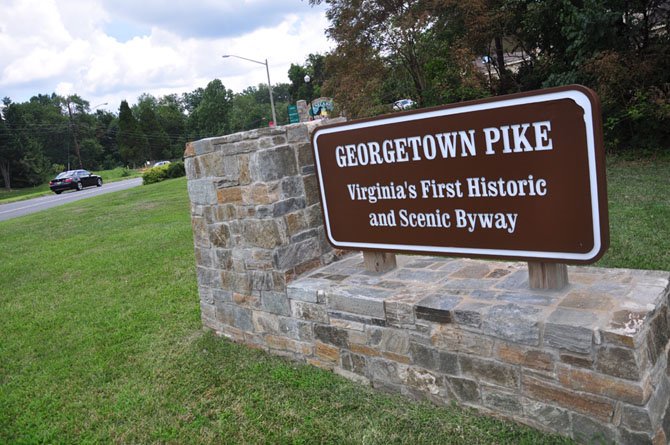Georgetown Pike, the state’s first scenic and historic byway, was named to the Virginia Register of Historic Places, and is up for national consideration. Photo by Alex McVeigh.
Great Falls — In 1969, several community members came together to help preserve the Burling Tract, a 336-acre parcel of land, located just north of Georgetown Pike near the Beltway. More than 40 years later, the efforts of at least 140 local citizens have led to the road being placed in the Virginia Register of Historic Places, with the placement on the National Register soon to come.
"The pike’s construction met the best engineering standards of its day by utilizing two layers of stones fitted closely together and crowned in the center to improve drainage and wear," reads the citation. "In the 1920s, Georgetown Pike was adapted as a toll road for automobiles and in 1934 the commonwealth of Virginia acquired it."
THE NAMING OF THE ROAD to the register is historic by itself.
"This is the first example of an entire road in Virginia being added to the register," said Tanya Beauchamp, a local resident who wrote up the submission to Virginia’s Department of Historic Resources. "Hopefully this serves as a model for future turnpike nomination."
The Burling Tract was eventually turned into public land, and heartened by this, local residents pushed for the 12-mile road to be named Virginia’s first Scenic and Historic Byway in 1974.
"During the 70s and 80s, there were significant battles, but we had that aura of being a byway," said John Adams, who has been involved with pike preservation since the first efforts with the Burling Tract. "It wasn’t necessarily legally defensible, but it made the engineers stop and listen to what we had to say."
Since the pike was named a byway, more than 2,700 miles of roadway in Virginia has been given the same designation.
With this designation, there was an impetus for the community to retain the road’s nature. Over the years, various efforts to add lanes or change the configuration were challenged, modified or rejected by community groups.
Local historian Karen Washburn, who assisted with the submission, said a milestone in protecting the pike was in 1994, when then Del. Vincent Callahan (R-34) and Sen. Janet Howell (D-32) helped create Senate Document 47. It was a 125-page blueprint governing every aspect of preservation and future changes.
"The key was showing that Georgetown Pike was indeed an engineered structure," Washburn said. "That was the absolute linchpin."
When the road was named a historic structure, the paved area, the adjacent road bed and nearby archeological artifacts, such as stone walls, were protected.
"We knew we had to defend every square inch of the pike, because once we gave in, it would set a precedent," Washburn said. "Once we found the arguments that worked, when it came to changes, we kept using them. Garrett Moore [Northern Virginia District Administrator for VDOT] was one of the best things to happen to us. He had a background in history, and it was a pleasant change."
With Moore’s assistance, as well as local state and county politicians, a plan to create a dual-turn lane from Leesburg Pike, which called for altering the configuration of the historic roadbed, was defeated.
Doug Cobb, co-chair of the Great Falls Citizens Association’s Long-Range Planning Committee helped look up addresses and map more than 600 people who live along the pike that had to be notified of the process.
"Putting it on the historic register puts a sheen on it, it makes it harder to disrupt and make changes," Cobb said.
GREAT FALLS HERITAGE INC., a 501(c)3, spent around $7,700 in their efforts to secure the designation. They are currently accepting donations to help cover the cost, which can be mailed to Great Falls Heritage, Inc., 820 Crooked Crow Lane, Great Falls VA, 22006.
The pike was approved by the Virginia Department of Historic Resources June 21, and will undergo a 45-day review process at the national level, which Cobb said they expect to hear about in September.


